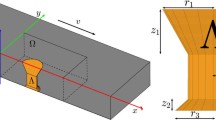Abstract
A prediction of the size of the heat affected zone (HAZ) should be made before cutting to select the proper cutting parameters and to reduce the size of the HAZ. A series of cutting experiments were carried out in this study by using an oxy-ethylene flame to obtain the widths of the HAZ for the I and V grooves of steel plates, and the effects due to variations in the cutting parameters were also investigated. The relationship between the cutting parameters and the widths of the HAZ were deduced by using a recursion technique as a statistical method, and simplified equations were derived in order to relate the widths of the HAZ and the cutting parameters. In order to verify the relationship obtained from the experiments, thermal analyses with numerical simulations were carried out based on the finite element method (FEM) to predict the sizes of HAZs as the cutting parameters varied. The results of the numerical analysis were compared to those obtained through experiments, and the comparison revealed that the numerical analyses were well matched to realistic cutting processes.
Similar content being viewed by others
Abbreviations
- \(\bar r\) :
-
effective radius of single Gaussian distribution (mm)
- T o :
-
initial temperature (°C)
- t :
-
plate thickness (mm)
- k :
-
thermal conductivity (W/mm °C)
- α:
-
thermal diffusivity (mm2/s)
- R :
-
distance from heat source (mm)
- v :
-
cutting speed (mm/s)
- C, U, L:
-
center, upper, and lower widths of HAZ (mm)
- E :
-
flow rate of ethylene (l/min)
- O :
-
flow rate of oxygen (l/min)
- A :
-
area of HAZ (mm2)
References
Ramaswamy, M. T., “Heat Affected Zone Studies of Thermally Cut Structural Steels,” M.Sc. Thesis, Department of Materials Science and Engineering, Oregon Graduate Center, 1989.
Pasko, Jr, T. J., “Heat-Affected Zone Studies of Thermally Cut Structural Steels,” U.S. Department of Transportation Federal Highway Administration, Publication No. FHWA-RD-93–015, 1994. http://ntlbtsgov/lib/jpodocs/repts_te/7783pdf (Accessed 29 MAR 2016)
Son, K. J., Yang, Y. S., and Beom, H. G., “Analysis of Angular Distortion in Weldments using Laminated Plate Theory,” Science and Technology of Welding and Joining, Vol. 5, No. 4, pp. 245–249, 2000.
Terasaki, T., Kitamura, T., Miyamoto, M., and Fujii, T., “Heat Input Generated in Plate by Gas Cutting Process,” Journal of the Japan Society of Naval Architects and Ocean Engineers, Vol. 10, pp. 197–204, 2009.
Thiébaud, R., Drezet, J.-M., and Lebet, J.-P., “Experimental and Numerical Characterisation of Heat Flow during Flame Cutting of Thick Steel Plates,” Journal of Materials Processing Technology, Vol. 214, No. 2, pp. 304–310, 2014.
Lindgren, L., Carlestam, A., and Jonsson, M., “Computational Model of Flame-Cutting,” Journal of Engineering Materials and Technology, Vol. 115, No. 4, pp. 440–445, 1993.
Hatala, M., “Microstructure Changes of Constructional Steel Caused after Thermal Cutting with Plasma Arc,” Proc. of the International Conference of the Carpathian Euro-Region Specialist in Industrial Systems, 2008. http://wwwnordtechubmro/issues/2008/2008.01.36. pdf (Accessed 29 MAR 2016)
Norusis, M. J., “SPSS 15.0 Guide to Data Analysis,” Prentice Hall, 2006.
Oh, K. H., Kim, H., Yoo, J. H., and Kim, T. J., “A Study on the Relationship of Explosion Characteristics and Combustion Heat of Gas Mixtures,” Journal of the Korean Institute of Gas, Vol. 1, No. 1, pp. 49–55, 1997.
Bae, K.-Y., Yang, Y.-S., Hyun, C.-M., and Cho, S.-H., “Simplified Mathematical Formulas for the Prediction of Deformations in the Plate Bending Process using an Oxy-Propane Gas Flame,” Proceedings of the Institution of Mechanical Engineers, Part B: Journal of Engineering Manufacture, Vol. 223, No. 2, pp. 155–161, 2009.
Rosenthal, D., “Mathematical Theory of Heat Distribution during Welding and Cutting,” Welding Journal, Vol. 20, No. 5, pp. 220s-234s, 1941.
Hibbitt, K., “ABAQUS/Standard User's Manual: Version 5.5,” Sorensen, Inc., 1995.
Author information
Authors and Affiliations
Corresponding author
Rights and permissions
About this article
Cite this article
Bae, KY., Yang, YS., Yi, MS. et al. A study on prediction of the size of heat affected zone in oxy-ethylene flame cutting of steel plates. Int. J. Precis. Eng. Manuf. 17, 733–740 (2016). https://doi.org/10.1007/s12541-016-0091-z
Received:
Revised:
Accepted:
Published:
Issue Date:
DOI: https://doi.org/10.1007/s12541-016-0091-z




